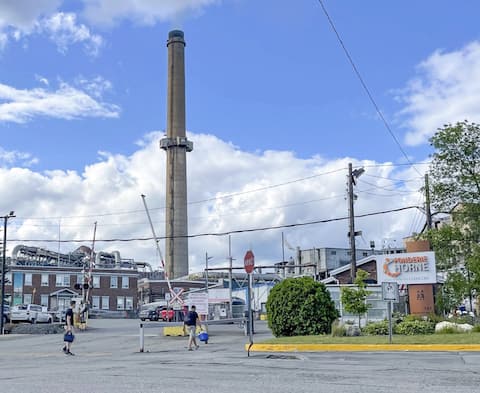The level of pollutant emissions in Rouyn-Noranda, in Abitibi-Témiscamingue, where the Horne Foundry is singled out, is not acceptable for the health of the population, estimates the national director of public health, Luc Boileau. The inhabitants of the city would have a greater risk of developing lung cancer there.
• Read also: Arsenic in Rouyn-Noranda: the Prime Minister no longer excludes the option of closure
• Read also: So, do we close it or we don’t close the Horne Foundry?
“For me, maintaining arsenic emissions at the current level is not tolerable considering the health impacts that are known. These emissions must be reduced to reach acceptable levels,” he argued, passing through Rouyn-Noranda, during a press briefing.
Last June, Radio-Canada revealed that the Dr Horacio Arruda, then national director of public health, had prevented in 2019 the dissemination of data on lung cancer in Rouyn-Noranda, which is higher in the region. The Dr Arruda would then have explained to act as “deputy minister”.
The Horne Foundry could be responsible for this situation, according to many health professionals. Its arsenic emissions into the air are currently capped, by acquired right, at a level of 100 nanograms per cubic meter, while the standard set by the Ministry of the Environment is rather three nanograms per cubic meter.
“I think there is a difference between the acceptable level and three nanograms. The three nanograms is a standard established by the ministry, to which is added a certain risk”, weighted the Dr Boileau, who believes that discussions will have to take place as to the risk deemed acceptable.
More cancers
On Wednesday morning, the National Institute of Public Health finally published its report on the situation in Rouyn-Noranda. If the status quo continues, there could be 13 to 554 additional cases of lung cancer per million population. Figures that would drop to 6.7 and 288 additional cases if emissions in the city were lowered to Quebec standards.
The calculation of the National Institute of Public Health of Quebec (INSPQ) is based on an exposure scenario 24 hours a day, seven days a week, for 70 years.
“We go well beyond the normally acceptable risks that we want to avoid when we are exposed to such contaminants. It is not because these figures represent smaller risks in terms of number that we must dodge the challenge that this represents, ”explained the Dr Boileau.
Public Health will nevertheless carry out more studies in the coming weeks in order to understand “as quickly as possible” the causes of the current situation, and whether other factors may contribute to this greater risk of suffering from cancer of the breast. lung.
“Over the next few weeks, and the next few months, we will move forward on this file with transparency, rigor and speed. We don’t want to extend the pleasure of studying for years to confirm things, “said Dr.r Boileau.
Possible closure
On Tuesday, in a scrum, Quebec Premier François Legault said he would not hesitate to close the Horne Foundry if it could not reduce its emissions to a level deemed safe, adding that discussions were underway. with the company.
“Either they reduce emissions to a level that respects the health of citizens, or, unfortunately, we will have to close the company. It will be one of the two. There will be no compromise for the health of citizens,” he insisted.
Photo QMI Agency, Thierry Laforce
The Prime Minister had also indicated that the government could grant financial assistance so that the factory can bring itself up to standard, but that it will also have to “invest significant amounts”.
Pressures
Since the situation in Rouyn-Noranda became public, several health professionals are urging the government to act.
Last Sunday, about fifty doctors had signed an open letter demanding government action. The College of Physicians and the Quebec Association of Physicians for the Environment both subsequently gave their support.
Tuesday, it was the turn of the Order of chemists of Quebec to intervene in the debate, considering that the government and Glencore had “accounts to render” to the residents of Rouyn-Noranda.
The Horne Foundry says it wants to improve
In a press release, the Horne Foundry, which belongs to Glencore, pledged to reduce “further” its atmospheric emissions.
The company argued its position on Wednesday afternoon, after the Public Health press briefing.
“We haven’t communicated it enough so far, but know this: we have a concrete plan to further reduce our emissions and are determined to improve the situation,” said Claude Bélanger, head of copper operations in North America. north of Glencore.
Four concrete actions are underway, according to him. In particular, the company would develop a “transition zone” between the Foundry and the Notre-Dame district to reduce the exposure of citizens, improve and add dust collectors, deploy projects that will allow the “optimal capture” of gas and dust, and would work to capture emissions from certain roof vents of the reactor.


